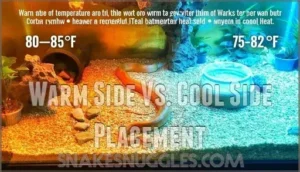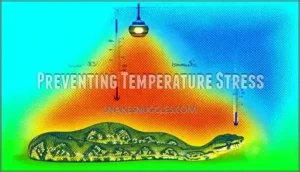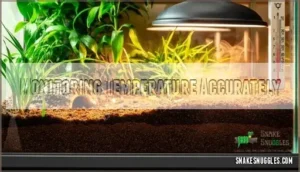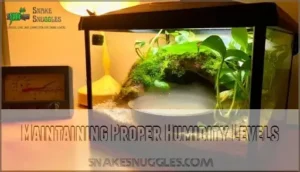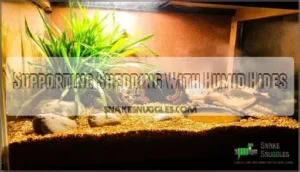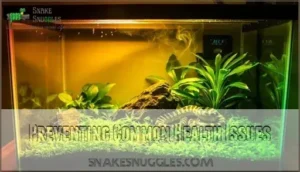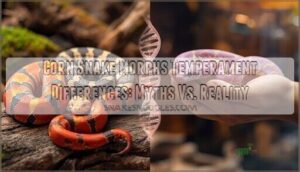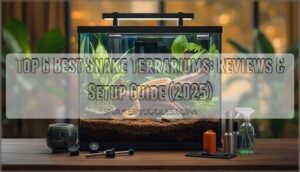This site is supported by our readers. We may earn a commission, at no cost to you, if you purchase through links.
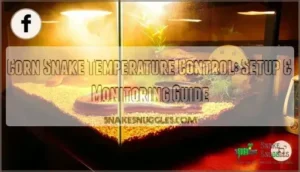
Unlike mammals, corn snakes can’t generate their own body heat. They rely entirely on external heat sources to power digestion, immune function, and movement. Get the gradient wrong, and you’re looking at respiratory infections, regurgitation, or a lethargic snake that refuses food.
The good news? Creating a proper thermal environment doesn’t require guesswork. With the right equipment and monitoring approach, you’ll establish stable conditions that keep your corn snake thriving year-round.
Table Of Contents
- Key Takeaways
- Ideal Temperature Range for Corn Snakes
- Setting Up a Temperature Gradient
- Heating Options for Enclosures
- Choosing and Installing Lighting
- Do Corn Snakes Need UVB Lighting?
- Monitoring Temperature Accurately
- Maintaining Proper Humidity Levels
- Supporting Shedding With Humid Hides
- Preventing Common Health Issues
- Essential Maintenance and Equipment Checks
- Frequently Asked Questions (FAQs)
- Conclusion
Key Takeaways
- Corn snakes require a precise thermal gradient with a warm zone at 80-85°F, a cool zone at 75-82°F, and a basking spot at 90°F—without this setup, they can’t digest food properly or maintain immune function.
- Temperature control equipment needs regular maintenance and monitoring with calibrated digital thermometers and thermostats, since even small deviations can trigger respiratory infections, regurgitation, or metabolic failure.
- UVB lighting isn’t mandatory but provides measurable health benefits including stronger immune function, better calcium absorption, and more natural thermoregulation behavior when installed correctly above the basking zone.
- Humid hides placed on both warm and cool sides of the enclosure prevent shedding problems by giving snakes access to moisture-rich microclimates without forcing them to sacrifice proper temperature regulation.
Ideal Temperature Range for Corn Snakes
Getting the temperature right isn’t guesswork—it’s about creating a thermal gradient that lets your corn snake regulate its body heat naturally.
Your enclosure needs distinct warm and cool zones, a proper basking spot, and nighttime conditions that support their natural rhythms.
Here’s what you need to establish for healthy temperature control.
Daytime Temperature Gradient
During the day, your corn snake’s enclosure needs a thermal gradient—a warm zone hovering between 80-85°F and a cooler retreat between 75-82°F—so your snake can shuttle between temperatures and thermoregulate like it would in the wild.
This gradient control isn’t optional. Without proper heat distribution, your snake can’t digest food efficiently or regulate its metabolism.
Think of it as giving your corn snake the freedom to choose its comfort level throughout thermal cycling.
Basking Area Requirements
Beyond that gradient, you’ll need to crank up a dedicated basking spot to 90°F—or just shy of it at 88-92°F—where your snake can soak up concentrated heat and kickstart digestion after a meal.
Position your heat lamp directly above a flat rock or branch to create a focused basking area roughly 6-8 inches wide. This concentrated heat source gives your corn snake precision temperature control without overheating the entire enclosure.
Nighttime Temperature Recommendations
Once the sun sets—or your lights click off—adult corn snakes do just fine with a natural drop to around 75°F, mimicking the cooler nights they’d experience in the wild. This thermal cycling helps regulate their metabolism without requiring constant ambient heat.
You can turn off your heat sources entirely at night as long as your cool zone doesn’t dip below 70°F—that keeps your snake comfortable while maintaining a healthy temperature gradient throughout the enclosure.
Safe Temperature Fluctuations
Your corn snake can manage temperature variance of 10-15°F between day and night without stress—this thermal cycling actually promotes healthy thermoregulation. Keep daily fluctuations within your temperature gradient (75-90°F range), and consider seasonal adjustments: slightly cooler winters and warmer summers mirror natural patterns. Just maintain consistent gradient control so your snake can always access its ideal basking spot for proper temperature regulation.
Maintaining ideal temperatures is vital for corn snakes, as they require a specific temperature gradient range to thrive.
Setting Up a Temperature Gradient
Your corn snake’s enclosure needs a clear temperature gradient—a warm side and a cool side—so your snake can regulate its body temperature naturally. Think of it as creating a thermal landscape where your snake can choose exactly what it needs.
Here’s how to set up that gradient and maintain it properly.
Warm Side Vs. Cool Side Placement
Setting up your corn snake’s home isn’t about just throwing in a heat source and hoping for the best—it’s about creating a thermal landscape where your snake can regulate its body temperature naturally.
Position your heating equipment on one end of the enclosure to establish distinct thermal zones. The warm side should hold steady at 80-85°F, while the cool side drops to 75-82°F. This heat distribution creates a proper temperature gradient, letting your snake shuttle between zones as needed for digestion, activity, or rest.
Creating Effective Basking Spots
A proper basking spot isn’t just the warmest patch in the tank—it’s where your corn snake actively heats up to power digestion and stay healthy.
Position a heat lamp directly above a flat surface—like a stone slab or sturdy branch—to create a focused basking area hitting 90°F.
This concentrated heat source allows precise snake thermoregulation within your thermal gradient, providing ambient warmth while your snake chooses when to absorb that critical energy boost for metabolic function.
Preventing Temperature Stress
Consistency becomes your snake’s best friend when preventing temperature stress. Maintaining stable thermal gradients within that critical 75-85°F range keeps your corn snake’s stress markers low and behavior natural.
- Monitor temperature fluctuations—daily swings beyond 10°F trigger physiological stress
- Position dual thermometers at snake level for accurate environmental control readings
- Use thermostats with heat sources to prevent dangerous temperature spikes
- Check both warm and cool zones daily for proper thermoregulation zones
To achieve ideal temperature control, understanding temperature gradient requirements is essential for creating a suitable environment.
Heating Options for Enclosures
You’ve got several heating options to choose from when setting up your corn snake’s enclosure, each with its own strengths and ideal use cases. The key is understanding which heat sources work best for different parts of your setup—from creating that perfect basking spot to maintaining gentle nighttime warmth.
Let’s break down the main heating methods and what makes each one tick.
Heat Lamps and Basking Bulbs
Think of heat lamps as your corn snake’s personal sun—they’re the ideal choice for creating that perfect basking spot your snake craves.
These heat sources produce infrared heating that penetrates deep into your snake’s body, supporting thermal regulation.
Position basking bulbs 12-18 inches above the substrate for best lamp placement and heat lamp safety.
Ceramic Heat Emitters for Nighttime
When the lights go out, ceramic heat emitters step in like silent guardians, maintaining that essential ambient warmth without disrupting your corn snake’s natural sleep cycle. These ceramic heating elements provide consistent nighttime temperature for snakes without visible light.
- No light emission – maintains natural darkness for proper sleep
- Consistent heat output – delivers steady ambient temperature control
- Long lifespan – ceramic heaters outlast traditional bulbs considerably
- Energy efficient – provides thermal control without excessive power consumption
Heat Mats and Deep Heat Projectors
Heat mats might seem like the obvious choice for belly warmth, but deep heat projectors actually deliver the infrared spectrum your corn snake craves most. Heat mats produce IR-C radiation that doesn’t penetrate effectively, while deep heat projectors emit IR-A and IR-B for enhanced thermal gradient control.
These infrared heating systems create natural temperature regulation from above, mimicking sunlight’s warming effects perfectly.
Recommended Product Features
Shopping for heating equipment can feel overwhelming, but focusing on a few key features will help you pick gear that keeps your corn snake comfortable for years to come.
Look for thermostats with accurate temperature probes and reliable sensor accuracy. Choose heat sources with dimming capabilities.
Consider models that integrate humidity controllers alongside your primary heat mat or UVB lighting setup.
Choosing and Installing Lighting
Your corn snake’s lighting setup does more than just brighten the enclosure—it drives their natural rhythms and bolsters overall health. Getting the timing and type of lighting right creates a foundation for proper thermoregulation and behavior.
Let’s walk through the key lighting considerations that’ll keep your snake thriving year-round.
Day/Night Lighting Cycles
Just like you need your morning coffee and evening wind-down routine, your corn snake thrives on a predictable daily rhythm of light and darkness. Proper photoperiod control maintains their natural circadian rhythm and encourages healthy behaviors.
- 12-hour daynight cycle mimics natural conditions
- Morning light activation signals feeding time
- Evening darkness promotes nocturnal simulation
- Consistent timing prevents circadian rhythm disruption
- UVB lighting integration bolsters diel lighting benefits
Seasonal Lighting Adjustments
Your corn snake’s internal clock doesn’t just need daily consistency—it craves the natural ebb and flow of seasonal changes that mirror what wild snakes experience throughout the year.
By tweaking lighting cycles—adding an hour of daylight in summer, reducing it for winter—you encourage healthier circadian rhythms, strong biorhythms, and authentic environmental enrichment.
Photoperiod control benefits both mood and activity patterns.
T5 HO UVB Fluorescent Tubes
If you’re aiming to give your snake’s setup a true taste of daylight, T5 HO UVB fluorescent tubes are the benchmark for bright, healthy enclosures. Their high output means reliable UVB intensity levels across larger tanks—key for proper Corn snake care.
With a consistent spectrum and straightforward T5 HO replacement, you support natural behaviors, temperature control, and overall reptile health in one elegant stroke.
Do Corn Snakes Need UVB Lighting?
Regarding corn snakes, UVB lighting is an option many keepers consider. It can affect your snake’s health, growth, and daily behavior in subtle but important ways.
Let’s look at what UVB can offer and how to set it up safely in your enclosure.
Health Benefits of UVB Exposure
Ever wondered if UVB therapy is more than a trend? UVB lighting for corn snakes isn’t just about visibility—it’s a pillar for reptile wellness. Health research shows benefits of UVB exposure like:
- Stronger immune function
- Increased calcium absorption
- Enhanced skin health
- Improved thermoregulation
- Prevention of metabolic bone disease
Lighting design truly impacts snake health.
Growth and Behavior Influences
Growth and curiosity tend to blossom when your snake soaks up the right kind of light. UVB’s Environmental Impact goes beyond the basics, helping regulate Growth Rates, Behavioral Patterns, and even Hormonal Influence.
It encourages postprandial thermophily, nudging your corn snake to bask after eating. With proper temperature gradient and control, you’ll see more natural activity and confident thermoregulation.
Installing UVB Lamps Safely
When you’re ready to bring UVB into your setup, a little planning goes a long way toward keeping both your snake and your wiring out of trouble. Mount UVB lighting above the basking zone, using sturdy, closed fixtures. Double-check electrical connections—loose wires are a fire risk.
Secure lamps against bumps, and never let heat fixtures dangle over substrate.
Monitoring Temperature Accurately
Getting your corn snake’s temperatures just right starts with accuracy. Let’s look at the tools and techniques that make it simple to monitor your setup.
Here’s what you’ll need to check and adjust temperatures with confidence.
Digital Probe Thermometer Placement
Getting your thermometer placement right can mean the difference between a thriving snake and one that’s struggling in the shadows. Always position digital probe thermometers on the basking surface and the substrate in the cool zone.
This gives you real-time temperature mapping and sharp thermal profiling. Calibrate regularly for sensor accuracy so your entire enclosure temperature stays true to your gradient plan.
Using Thermostats and Dimmers
Think of thermostats and dimmers as the brakes and gas pedal for your snake’s heating system—giving you precise control so temperatures never run wild.
- Calibrate your thermostat routinely for reliable temperature control.
- Use dimmer switches for fine-tuned temperature ramping.
- Choose appropriate thermostat types for each heat mat or lamp.
- Set up dimming controls to adjust your temperature gradient without fuss.
Regular Temperature Checks
How often do you actually pause to double-check the temperature in your snake’s setup—because even a small change can make all the difference. That’s why regular thermal monitoring and keeping Temperature Logs guard against surprises.
Use a reliable thermometer to record ambient readings, check your heat source, and verify your temperature gradient, ensuring precise temperature control for proper snake thermoregulation.
Maintaining Proper Humidity Levels
Keeping your corn snake’s humidity in the right range isn’t complicated, but you do need the right setup. A few simple tools make it easy to keep things stable.
Here’s what you can use to control humidity in your enclosure.
Ideal Humidity Range
A steady humidity level is one of the secret ingredients to keeping your snake’s skin smooth and your habitat running trouble-free. Ideal humidity for corn snakes sits between 40% and 60%. You’ll reach this range with a balance of substrate moisture, water bowls, and proper misting schedules.
Consistent humidity control promotes healthy shedding and keeps air quality just right.
Using Hygrometers
You can’t keep tabs on your corn snake’s humidity levels without a good hygrometer watching your back. Place digital hygrometers on both the warm and cool sides of your enclosure to capture accurate readings across the temperature gradient.
Calibrate your device every few months using a salt test—it takes five minutes and prevents false readings that could throw off your entire humidity control strategy.
Adjusting Humidity With Substrate and Misting
Once your hygrometers confirm the current levels, substrate choice and strategic misting become your two most powerful tools for dialing humidity up or down. Moisture-retentive substrates like cypress mulch hold water better than aspen, creating humid microclimates near the surface.
Light daily misting raises humidity temporarily—just don’t soak the enclosure. Pair this with a larger water bowl for passive evaporation, and you’ll hit that ideal range without turning your tank into a swamp.
Supporting Shedding With Humid Hides
When your corn snake approaches a shed cycle, it needs extra moisture to slip out of its old skin cleanly. A humid hide acts as a dedicated microclimate where your snake can retreat when it’s time to shed.
Let’s look at how to set one up and keep it working effectively.
Benefits of Humid Hides
Humid hides act like personal saunas for your corn snake, giving them a moisture-rich retreat that makes shedding easier and keeps their skin healthy.
When humidity levels drop in the main enclosure temperature zones, these hides provide a backup moisture source. Your corn snake can self-regulate hydration by moving between the temperature gradient and the humid hide, preventing stuck shed and eye caps.
Creating and Placing Humid Hides
Building an effective humid hide takes just a few minutes—grab a plastic container with a lid, cut an entrance hole large enough for your snake to slip through comfortably, and fill it with damp sphagnum moss or paper towels.
Place one humid hide on the warm side near the basking spot and another on the cool side of the temperature gradient. This setup lets your snake access moisture control without sacrificing proper enclosure temperature regulation during shedding cycles.
Monitoring Humidity in Hides
Check the moisture levels inside your humid hides every few days by gently squeezing the substrate—it should feel damp like a wrung-out sponge, not dripping wet or bone dry. Use a hygrometer to track humidity levels and maintain environmental stability inside each hide box.
Essential humid hide maintenance steps:
- Replace substrate weekly during shedding cycles to prevent mold growth and maintain consistent humid microclimates
- Monitor with humidity sensors placed near hide openings to track moisture without disturbing your snake
- Refresh through misting when readings drop below 60%, focusing on substrate saturation rather than enclosure-wide spraying
- Inspect after each shed to remove skin remnants and verify the humid hide supported complete snake shedding
Preventing Common Health Issues
When temperature and humidity drift out of range, your corn snake’s health can take a hit fast. Respiratory infections, digestive slowdowns, and stress-related problems are all tied to environmental missteps.
Here’s what to watch for and how to keep your snake thriving year-round.
Respiratory and Digestive Risks
Poor temperature control opens the door to serious respiratory issues and digestive problems in corn snakes. When temperatures drop below ideal ranges, digestion slows dramatically—fecal passage can stretch from three days to over seven, increasing infection risks and regurgitation.
Respiratory infections also spike under temperature stress, with infection clearance rates plummeting below 60%.
Maintaining a proper temperature gradient isn’t optional—it’s essential for thermoregulation and digestion, preventing dangerous secondary infections that thrive when your snake’s immune system weakens.
Proper temperature gradients aren’t optional—they’re the foundation of corn snake health, preventing infections that thrive when immune systems weaken
Recognizing Signs of Temperature Stress
Lethargy hitting within 30 minutes, refusing food, or constant escape attempts—these aren’t quirks. They’re red flags for temperature stress. Watch for rapid breathing, sunken eyes, or incomplete sheds when enclosure temperature strays beyond 70–90°F.
Poor thermoregulation weakens immune function fast, triggering heat stroke or cold shock. Your basking spot and temperature gradient must stay dialed in, or you’re risking multi-organ damage and infections that thrive when thermal cycling fails.
Seasonal Temperature Adjustments
Wild temperatures don’t pause just because your snake’s inside—mimicking seasonal shifts actually strengthens immune function and reproductive health in captive corn snakes. Annual adjustments support thermoregulation and digestion while preventing metabolic stagnation.
Thermal cycling essentials:
- Drop basking temps to 85°F and extend your seasonal light cycle to 13 hours during summer
- Raise cool-side zones to 75°F and reduce lighting to 11 hours in winter
- Adjust temperature ramps gradually over 2–3 weeks to avoid shocking your snake
- Use temperature measurement tools and climate control systems to verify your temperature gradient stays consistent
Essential Maintenance and Equipment Checks
Keeping your corn snake’s environment stable isn’t a one-and-done deal.
Regular maintenance of heating equipment prevents malfunctions that could put your snake at risk. Here’s what you need to check and when to do it.
Cleaning and Inspecting Heating Devices
Regular cleaning and inspection of your heating equipment isn’t just good housekeeping—it’s a critical safety measure that guarantees your corn snake’s thermal environment stays stable. Dust buildup on heat lamps and heating elements reduces efficiency and creates fire hazards.
Weekly inspection schedules help you catch frayed cords or thermostat drift early. Clean your heat mat surfaces monthly and verify equipment calibration with your thermometer.
Proper thermal maintenance and device sanitation keep your temperature control system reliable.
Replacing Bulbs and Heat Sources
Even the most reliable heating equipment has a shelf life, and knowing when to replace bulbs or upgrade worn-out heat sources protects your snake from sudden temperature drops that could compromise its health. Track these replacement schedules to maintain ideal temperature control:
- Replace heat lamp bulbs every 6-12 months—even if they still glow, energy efficiency declines
- Swap ceramic heat emitters after 18-24 months of continuous use
- Check heat mat adhesion and function annually
- Replace thermostats showing calibration drift or erratic readings
- Upgrade heating equipment if it fails to reach target temperatures consistently
Ensuring Reliable Power and Controls
Temperature control hardware means nothing without dependable electricity flowing through it, so let’s talk about backup power plans and surge protection that keep your snake’s environment stable when the unexpected happens. Invest in a UPS (uninterruptible power supply) for your thermostat and heat lamp—it buys you hours during outages. Plug all heating equipment into surge protectors to shield sensitive control panels from voltage spikes.
| Power Backup Systems | Protection Level |
|---|---|
| UPS battery backup | 4-8 hours runtime |
| Surge protector strips | Voltage spike defense |
| Generator (emergency) | Extended outage coverage |
| Dual thermostat setup | Redundancy safeguard |
| Regular electrical inspections | Preventive maintenance |
Check thermostat settings monthly and test your backup systems quarterly to verify your temperature gradient stays rock-solid.
Frequently Asked Questions (FAQs)
How often should I calibrate my thermometer?
Calibrate digital probe thermometers every three to six months to maintain temperature accuracy. More frequent sensor validation guarantees reliable temperature measurement—critical for proper temperature regulation.
Cross-check readings with an ice bath test for probe maintenance.
Can room temperature affect enclosure heating costs?
Absolutely—ambient room temperature directly impacts your energy costs. A colder room forces heating elements to work harder to maintain the temperature gradient, increasing electricity use.
Insulation and efficient heating methods help regulate enclosure temperature while reducing expenses.
What backup heating options work during power outages?
During power outages, hand warmers and insulated blankets provide emergency heat. Battery-powered heat mats or portable generators support backup systems. Thermal mass from heated stones retains warmth temporarily.
Deep heat projectors and ceramic heating elements require alternative power, while heat guards prevent burns around emergency heat sources.
Do hatchlings need different temperatures than adults?
Hatchlings and adults thrive at the same temperature gradient—75-82°F cool side, 80-85°F warm side, with a 90°F basking spot.
Your corn snake’s thermoregulation needs don’t shift with age, though hatchlings may bask more frequently during growth stages.
How do I transition between seasonal temperature settings?
Gradual changes work best—think of it like easing into fall weather. Shift basking spots by 2-3°F every few days over two weeks.
Pair thermal cycles with seasonal light adjustments: 13 hours summer, 11 winter. This mimics natural climate adjustments without shocking your snake’s thermoregulation.
Conclusion
Here’s the reality: most corn snake health issues trace back to temperature mismanagement. Your snake won’t thrive in "close enough" conditions—it needs precise corn snake temperature control. A reliable thermometer, a quality thermostat, and consistent monitoring aren’t extras. They’re necessities.
The gradient you create determines whether your snake digests meals properly, sheds cleanly, and maintains a functional immune system. Get the setup right once, and maintenance becomes routine. Your snake’s biology depends on the environment you control.
- https://www.semanticscholar.org/paper/Does-exposure-to-UVB-light-influence-the-growth-and-Palmer/0014580c213ab41081af864d56ed6bae3332c81d
- http://www.lightyourreptiles.com/arcadia-d3-t-5-22-inch-24-watt-6-forest-uvb/
- https://www.reptilebasics.com/t5-light-fixtures/shadedweller-max/
- https://reptifiles.com/corn-snake-care-guide/corn-snake-temperatures-humidity/
- https://zoologicalstudies.springeropen.com/articles/10.1186/1810-522X-52-33

